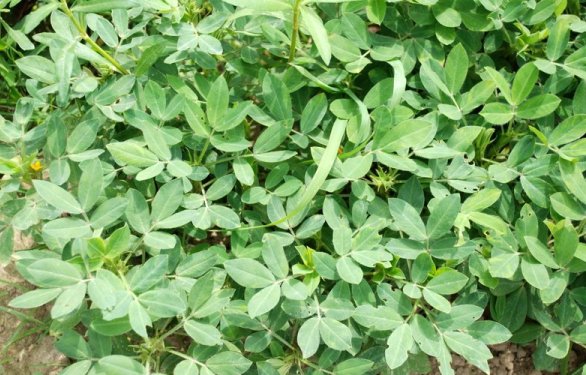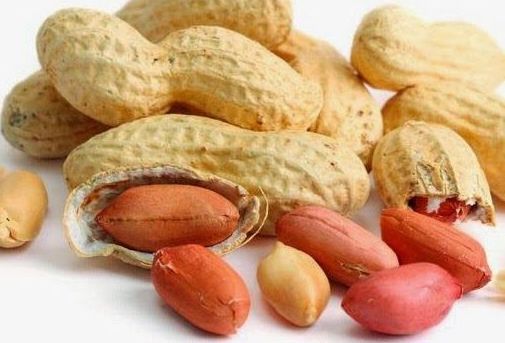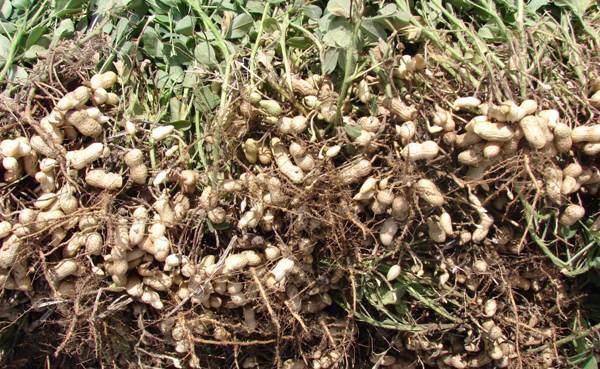Peanut Farming Guide:

Introduction of Peanut Farming:- Peanut also knows as Groundnut is one of the top oil-seed crops grown in Asian countries. Peanut is widely grown in the tropics and subtropics, being important to both small and large commercial growers. Peanut is an annual herbaceous plant that may reach up to 50 cm height. Peanut belongs to the family of “Fabaceae” and genus of “Arachis”. India is the second largest producer of Peanuts next to China in Asia. Peanuts are used in culinary preparation by roasting, making peanut flour and extracting peanut oil. Peanuts are rich in essential nutrients. In a 100 grams serving of peanuts provide 550 calories and are an excellent source of several B vitamins, vitamin E, several dietary minerals, such as manganese, magnesium and phosphorus, and dietary fiber. Peanut seed contains about 40 to 45 % of oil and 25 % of protein. Peanut kernel is very easy digestible and the oil cake obtained after the extraction of the oil from Peanut is a valuable organic manure and animal feed. It contains 6 % ‘N’, 1 % phosphorus and 1% potash. Peanut is a good rotation crop which builds up the soil fertility by fixing atmospheric nitrogen through the root nodules. Peanut Farming is also an excellent cover crop especially for lands exposed to soil erosion. Commercial Farming of Peanut is pretty much successful and one can easily make decent profits provided certain field management procedures are practiced.
Health Benefits of Peanut:– The following are some of the health benefits of Peanut.

- Peanuts help in promoting fertility.
- Peanuts help in fight depression.
- Peanuts boost memory power.
- Peanuts aid in blood sugar control.
- Peanuts help in cancer prevention.
- Peanuts help in preventing gallstones.
- Peanuts boost memory power.
- Peanuts help in lowering cholesterol levels.
- Peanuts help in lowering the risk of heart problems.
- Peanuts help in lowering risk of weight gain.
Common Names of Peanuts:- Peanuts, Earthnuts, Goober peas, Monkey nuts, Pygmy nuts and Pig nuts.
Local Names of Peanut in Other Parts of World:– Erdnuss (German), Gazryn samar (Mangolian), Kikiriki (Bosnian), Ddangkong (Korian),Badam (Nepali), Cacahuate (Spanish), фъстък (Bulgarian), 花生 (Chinese), fūl sudāni (Arabic),ถั่ว (Thai), Arachide (Italian), đậu phộng (Vietnamese), pīnatsu (Japanese),arachide (French), សណ្ដែកដី (Cambodian), арахис (Russian), Rata kaju (Sinhalese, Sri Lanka), yer fıstığı (Turkish), Kacang Tanah (Malay), badam-kuhi (Persian), 花生 (Taiwanese).
Local Names of Peanut in India:- Moong phalli (Hindi, Kashmiri, Panjabi),China badam (Bengali, Oriya), Bhoising (Gujarati), Kadale kayi (Kannada), Nilakkadalai (Malayalam, Tamil), Bhui mug (Marathi), Verusanaga (Telugu).
Peanut Varieties:- There are many improved high yielding varieties available in most of the regions in Asia. However, one should get the information from local agriculture departments for appropriate cultivar.
Climate Required for Peanut Farming:- Peanut can be grown in both tropics and sub-tropics. Basically it requires a long and warm growing season and well-distributed rainfall during its growth period. For good yield, it needs enough sunshine and warm climatic conditions. The best suitable temperature for Peanut Farming is 22 °C to 30 °C. Lower temperatures will reduce the crop yield and quality of the nuts. Especially, this crop requires warm and dry climate at the ripening stage.
Soil Requirement in Peanut Farming:- Peanut grows well in well-drained sandy and sandy loam soils because light soil helps in easy penetration of roots and their development and also harvesting. Avoid clay or heavy soils as they are not suitable for this crop. If you are planning on large scale or commercial production, it is advised to for soil testing and the suitable soil pH for peanut growing should be between 6.0 and 7.0.
Land Preparation in Peanut Farming:- It is advised to plough with tractor using a disc followed by harrow till all the clods are broken and a fine tilth stage is achieved. Avoid deep ploughing as it encourages development of pods in deeper layers of soil which makes harvesting difficult. Supplementing the soil with appropriate well decomposed farmyard manure (FMY) will result in good yield. If the soil test is carried out, incorporate the required soil micro-nutrients during the preparation of the field.
Propagation and Sowing in Peanut Farming:- Propagation of Peanut is done by seeds. Select only quality high yielding seed which has more disease resistant properties. Treating the selected kernels with 5 grams of Thiram per kg of kernels will ensure to check various seed and soil borne diseases. Seed should be inoculated with proper strain of Rhizobium culture particularly in those regions where peanut is to be cultivated for the first time.
If you are planning for rainfed crop, seeds should be sown just before monsoon starts. Sowing should be done as early as possible as delayed sowing can result in reduction of the yield. If the crop is cultivated under irrigated conditions, sowing can be done in November or December. When it comes to spacing it depends on the cultivar and soil type. In case of bunch types, the row to row spacing should be 30-40 cm where as in spreading types 45-60 cm. Seed rate also depends on the variety of Peanut. If you are planning for bunch type crop, 90 to 100 kg of Peanut seed is required for 1 hectare land where as in spreading types, 65 to 80 kg/ha is required. Plant-to-Plant spacing should be 15 cm and 20 cm for bunch and spreading type’s respectively. Sowing of Peanut should be carried at the depth of 5 cm. This can be done by plough or with the help of dibbler or seed planter. For commercial Farming of peanuts, seed planter should be used.
Crop Rotation and Mixed Cropping in Peanut Farming:- Generally, Peanut can be cultivated in rotation with pea, barley, wheat and any other gram crop. Peanut can be grown as a mixed crop with maize (corn), grains, castor and cotton. Peanut can also be followed by safflower crop where early cultivars are grown and moisture remains in the soil at the time of harvesting.
Manures and Fertilizers in Peanut Farming:- Supplement the soil with well- decomposed farmyard manure of 20 to 25 tonnes per hectare during the preparation of land and after carrying the soil test, apply NPK fertilizers as per the outcome of soil test. If soil test is not done, carry out the application of N: P: K as below mentioned.
N P K Sulphur
25 kg/ha 50 kg/ha 75 kg/ha 60 kg/ha
‘N’ and ‘K’ should be applied in 3 three split doses; 50 % of ‘N’ & ‘K’ as basal + 25 % of ‘N’ and ‘K’ at 21 day after sowing + 25 % of ‘N’ and ‘K ‘at 45 day after sowing is advised.
The fertilizer should be applied at the time of sowing about 4 cm in the side of the seed and 4 cm below the seed level. Calcium too has tremendous effect on proper development of pods, kernels and overall yield. Hence, making sure sufficient calcium in the soil is very important. To overcome the calcium deficiency, gypsum should be applied at the rate of 120 – 125 kg per hectare.
Irrigation in Peanut Farming:- Irrigation is not required if it is grown as rainy season crop. However, under drought conditions, it requires timely watering for better quality of pods and higher yields. In case of heavy rains or flooding, the filed should be well-drained. Installing drip or sprinkler system will help in utilizing water in proper way. Irrigation depends on the soil type and should be given without fail especially at the start of flowering and the subsequent irrigations whenever required during the fruiting period to encourage roots penetration and pod development. At the time of harvesting, it is required to give irrigation to facilitate the full recovery of pods from the soil.
Regulation of irrigation according to the following growth phase of the crop is essential for proper pod development and growth.
- Pre-flowering stage: 1 to 25 days
- Flowering stage: 26 to 60 days.
- Maturity stage: 61 to 105 days.
Pegging, flowering and pod development phases are more critical stages for irrigation during which the crop expects sufficient soil moisture. Carry out the irrigation as follows:
Sowing or pre-sowing:
- Life irrigation: 4 to 5 days after sowing if sowing irrigation given to break the surface crust.
- Give irrigation 21 days after sowing.
- At flowering: Give 2 irrigations.
- At pegging stage: Give 1 or 2 irrigation.
- In pod development stage: 2 to 3 irrigations depending on the soil type.
Weed Control in Peanut Farming:- Usually, 1 or 2 hand hoeings and weedings should be carried out and this depends on soil type. First hoeing should be carried 3 weeks after sowing and the second, three weeks thereafter before commencement of flowering. Make sure that the soil is not distributed at pod formation stage. Weedicides like TOK-E-25 at the rate of four liters dissolved in 600 liters of water can be applied as pre-emergence spray. The earthing up operation should also be carried simultaneously with inter-cultural operations. The idea behind earthing up is to promote easy penetration of roots (pegs) in soil. This can also facilitate more area to spread in soil layers.
Pests and Diseases in Peanut Farming:- The common pests found in Peanut Farming are; Red Hairy caterpillars, Jassids, Peanut leaf miner, Thrips, Bihar hairy caterpillar, Jewel beetle Gram pod borer, Termites, Tobacco caterpillar, White grubs, Peanut bud borer, Pod borer, Aphids and Pod bug.
The common diseases found in Peanut farming are; Early Leaf Spot, Late Leaf Spot,Rust, Stem Rot, Bud Necrosis and Alternaria Leaf Disease.
For control measures of these pests and diseases in Peanut Farming, contact local agriculture department. However, selecting quality seeds and treating the seeds before sowing will reduce the most of seed borne and soil borne disease occurrence.
Harvesting in Peanut Farming:- It is essential to dig the pods at the right time for obtaining higher yields of pods and oil. Drying and falling of older leaves, yellowing of the top leaves indicate the maturity. Pull out a few plants at random and shell the pods. If the inner shell is brownish black and not white, then it indicates that the crop is matured. To facilitate easy harvesting, irrigate once before harvesting which make the soil loose. One can use hi-tech machinery available for harvesting peanut crop.

Yield in Peanut Farming:- Yield of the peanut crop depends on many factors like soil type, irrigation, climatic conditions, and cultivars and finally the farm management practices. If all are well, Up to 20 quintals of pods per hectare from bunch type varieties and Up to 30 quintals per hectare from spreading varieties can be obtained.
Marketing in Peanut Farming:- Well dried Peanuts or Groundnut can be taken to local markets or can have a contract to supply in bulk to oil companies.
For sheep farming or Goat farming Info: Read here.
For Indian Agriculture Info: Read here.
